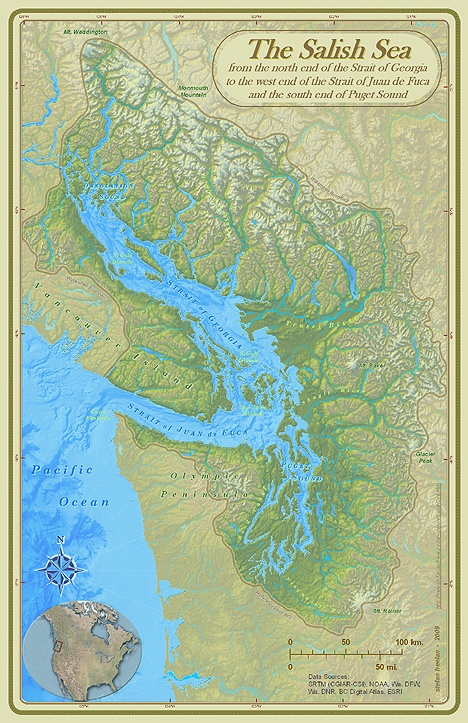— Editor’s note: This story was originally posted Friday and was updated Saturday. References to “today” refer to Friday.
The state Board on Geographic Names today approved “Salish Sea” as the collective name for the body of water that includes Puget Sound, the Strait of Juan de Fuca, and Georgia Strait.
The new designation does not change or eliminate the names of any of the several bodies of water within the Salish Sea on either side of the international border. It does mandate that cartographers use “Salish Sea” on all maps and in all atlases.
The term, which has been adopted by the British Columbia Geographical Names Office, is already used by some scientists to describe the unified ecosystem and habitats of the inland waters. Supporters say the name recognizes this convergence of straits for what it is — an inland sea — and recognizes the Coast Salish peoples who were the first residents of these waters.
The proponent of the proposal for an official geographical name to describe the entire body of water as the Salish Sea was Bert Webber, a retired professor of marine biology from Bellingham.
With the board’s approval today, the state’s designation of “Salish Sea” as the name of the collective inland waters will be considered for adoption for federal use by the United States Board on Geographic Names. The Geographical Names Board of Canada has approved a resolution to adopt the name contingent on U.S. approval.
The San Juan Islands are in the middle of an inland sea, surrounded by the Strait of Georgia to the north, Haro Strait to the west, Rosario Strait to the east, and the Strait of Juan de Fuca to the south. But the area is often called Puget Sound, which is a misnomer, because Puget Sound begins at Admiralty Inlet.
Dr. Wayne Suttles, the late anthropologist who spent much of his career studying Coast Salish culture and language, insisted this body of water was an inland sea and thought the name “Salish Sea” was appropriate because the Coast Salish people were the first inhabitants of the lands around these waters.
Shann Weston, a naturalist and coordinator of the WSU Beach Watchers program, studied under Webber at the Huxley College of Environmental Studies at Western Washington University. She said the designation “Salish Sea” will help people see the body of water as a single bioregion that knows no political boundaries. That will also help us understand how we impact the marine environment.
“It acknowledges a bioregion that’s not subject to political boundaries that are only 147 years old,” she said. “It’s a cohesive bioregion. It also makes it excellent for us to interpret what’s really happening here with our whales and salmon that cross over that little dotted line.”
In a March 8, 2008 Times Colonist article, Aboriginal Relations Minister Mike de Jong, said he supported the Salish Sea designation, after Chemainus First Nation representative George Harris raised the idea at a First Nations Summit.
“It is descriptive of the geographic location of the body of water, and I also think it recognizes the history of our province extends further than 150 years,” de Jong told the Times Colonist.
Peter Keller, dean of social sciences at the University of Victoria, told the Times Colonist that any contemplated name change should first include consultation with First Nations.
“During the era of colonization, we assumed the right to name features that already had traditional names associated with them,” Keller said.
The state Board on Geographic Names is a seven-member board authorized by state law to establish the official names for lakes, mountains, streams, places, towns, and other geographic features. The board meets at least twice a year and may hold special meetings as called by the chair or a majority of the board. All meetings are open to the public.
Commissioner of Public Lands Peter Goldmark chairs the board and appoints four members from the general public to serve three-year terms. The two other members are the State Librarian and the chair of the Washington State Heritage Council.
Other stories about the Salish Sea designation:



